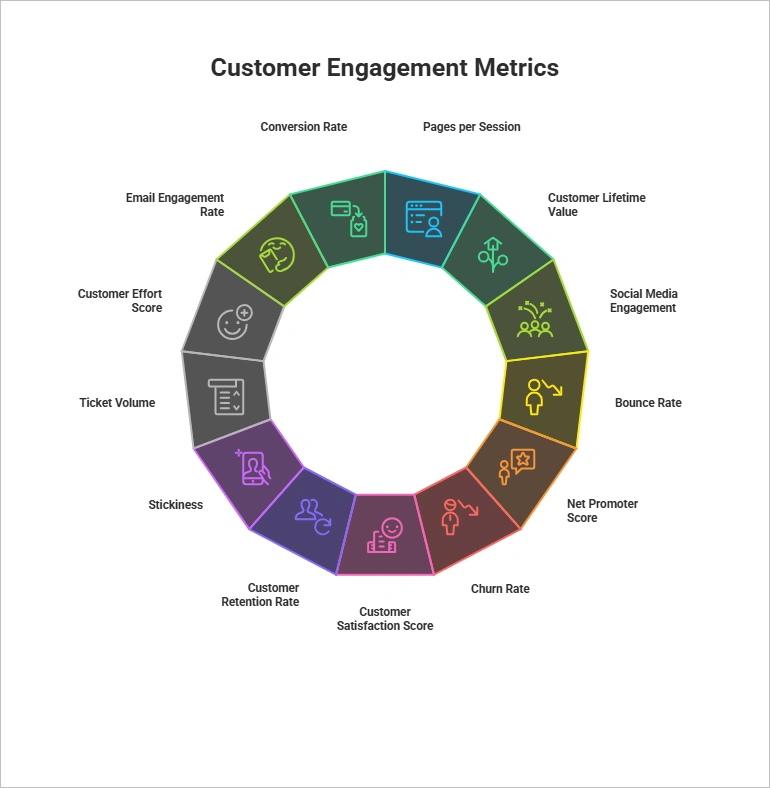Doing business is simpler because of faster communication. Better communication directly reflects how customers will be engaged with your business.
To understand how customers are engaged, it is important to track customer engagement metrics. The only problem is identifying which customer engagement metric suits your business.
This blog will discuss some of the essential customer engagement metrics that you can track in your business for long-term success.
What is customer engagement?
Customer engagement involves interactions, beyond average business transactions, made between your business and its customers.
Customer engagement is the building of meaningful relationships with your customers, ultimately leading to customer loyalty.
Lack of engagement with your customers means there will be reduced levels of trust and emotional connection with your brand. This negatively impacts business growth and success.
You can engage with your customers through multiple communication channels such as:
- Emails
- Live chat
- Websites
- Phone calls
- Reviews
- Direct communication
For this reason, customer engagement metrics will provide you with all the key indicators to track the relationship between your business and your audience.
Top customer engagement metrics to track
Tracking customer engagement metrics is important to learn if your brand has set standard business objectives. Identifying the best customer engagement metrics to track can be a challenge.
To make it easier for you, here are some of the top customer engagement metrics you can track.

1. Pages per session
Pages per session measures the number of pages visited by a user during a single session on your website.
This metric identifies the interaction of users with your website based on its usefulness and how engaging your content is.
A higher page-per-session rate indicates that your content is engaging and helpful. On the other hand, a lower page-per-session rate indicates that your content lacks the proper structure and is most likely irrelevant to your audience.
The following tips improve low page-per-session rates:
- Site structure: For improved engagement, it’s essential that your website be user-friendly and easy to navigate. This ensures that users can seamlessly transition from one page to another without confusion.
- Internal links: This allows users to find relevant topics, saving time and improving engagement. The links have to be sufficient to reduce instances of overcrowding. For easier navigation, use the appropriate keywords, placing them naturally to avoid confusion.
2. Customer lifetime value
This is a customer engagement metric that measures the expected revenue that can be collected from a single customer during the course of their relationship.
To make informed investment decisions for customer acquisition and retention strategies, it helps identify the most profitable customer categories.
To increase your customer lifetime value, always provide innovative and engaging products. Additionally, customer service has to be positive and seamless to reduce chances of customer churn.
Data received from the sites include previous sales data and amount of revenue collected in a specific time frame.
Formula for customer lifetime value:

3. Social media engagement
Social media engagement defines how people interact with your brand on social media platforms.
It allows businesses to gain insight into how individuals perceive their brand and products, which can range from positive to negative reactions.
From the interactions, it is possible to know how your audience resonates with your brand. Better social media engagement leads to customer loyalty and retention.
To track this metric, you can analyze the likes, comments, follows and retweets made by people. Different social media platforms have different measurement metrics.
In spite of this, you can measure how engaged customers are with your content and use the obtained information to develop a social media campaign that meets your audience standards.
Formula for social media engagement:

4. Bounce rate
Bounce rate is a percentage that represents visitors who leave your website after viewing one page without subsequent action.
Typically, visitors will view your content for a few seconds and then leave. This metric provides insights on how visitors rate your content.
Most websites have a bounce rate ranging from 26% to 70%.
- A low bounce rate indicates that your audience finds your content engaging and your website easy to navigate.
- Higher bounce rates, on the other hand, can be due to irrelevant content, a lack of proper structuring, slow loading times, or poor design.
Businesses should strive to have a low bounce rate because customers should stay engaged with the content to better understand a product or service.
Formula for bounce rate:

5. Net promoter score
Net promoter score (NPS) is a customer engagement metric used to measure customer loyalty and satisfaction based on their willingness to recommend your brand to others.
The metric uses one simple question, “How likely are you to recommend our product to your friends?”
Feedback is taken on a scale of 1-10. Below is an illustration of how the scale is analyzed.
| Scale | Designation |
| 0-6 | Detractors |
| 7-8 | Passive |
| 9-10 | Promoters |
This metric can be calculated by subtracting the percentage of detractors from promoters. You can track the metric by conducting an NPS survey to test customer loyalty and calculate the scores from the data.
Information from the net promoter score can be used to determine the levels of customer engagement.
Formula for net promoter score:

6. Churn rate
Churn rate is the percentage of customers who discontinue their engagement with a business after a period.
Regardless of the reasons, customers will leave when they feel the product or service lacks value.
Assessing this rate can identify areas needing improvement and prevent customers from leaving.
To promote business success, it is important to reduce churn rates by coming up with effective customer retention strategies.
Formula for churn rate:

7. Customer satisfaction score
A customer satisfaction score is a rating used to determine how happy your customers are with your business. It is a feedback mechanism that requires customers to share their levels of satisfaction based on their experiences.
Typically, it can be customized as a question and is normally used following an engagement or interaction with a customer.
This metric can be tracked using a CSAT survey. Customer satisfaction is important in any business venture.
- A higher CSAT score represents a happy customer.
- A lower CSAT score represents an unhappy customer.
With the competitive nature of businesses, it is crucial to ensure that your customers are always happy with your products or services.

The ratings are normally on a scale of 1–5, with 1 indicating the customer is unhappy or unsatisfied with your product or service, and 5 indicating that the customer is extremely satisfied and happy with your product or service.
Formula for customer satisfaction score:

8. Customer retention rate
The customer retention rate is a metric used to determine customers who remain loyal to your business over a duration of time.
A higher customer retention rate indicates positive customer engagement, making it possible to turn your frequent buyers into loyal customers.
To calculate this metric, focus on data from a specific period and obtain information at the start and finish of that period.
Formula for customer retention rate:

E- Customers you have at the end.
N- Customer acquired during measuring period.
S- Customers you have at the start.
9. Stickiness
Stickiness is a measure of how happy your customers are with your services or products. These are customers whose chances of returning are high with minimal chances of switching to your competitors.
Such customers can be upsold or cross-sold easily, reducing the total investment for marketing campaigns.
Formula for stickiness:

10. Ticket volume
Measures support channels with the most customer engagement. It is used to understand how customer support requests are handled and distributed across support channels. A higher ticket volume indicates which support channels are preferred by customers for making complaints.
It is important to track this metric because it provides insight into the support channels that may require optimization via training.
11. Customer effort score
Customer effort score is used to measure the interactions of customers when resolving an issue or completing a task. Insights from this customer engagement metric can be used to improve on areas within your business that lead to a poor customer experience.
Because it is a feedback metric, it can be tracked by designing a customer effort survey. Your customers can rate their experiences from a scale of 1-5.
Formula for customer effort score:

12. Email engagement rate
Email engagement rate measures how customers interact with your email messages or campaigns, especially when doing email marketing. This customer engagement metric can be tracked using open rates and click-through rates.
Formula for email engagement rate:


13. Conversion rate
Conversion rate measures the percentage of users who meet the goal of your customer engagement effort. These actions could be:
- Downloading your product
- Subscribing
- Purchasing
The higher the conversion rate, the more successful your engagement efforts. Tracking the metric involves measuring conversion rates based on website interactions, marketing strategies, etc.
Formula for conversion rate:

Benefits of measuring customer engagement metrics
Customer engagement is a crucial part that defines a business. As such, customer engagement metrics are invaluable to any business worth its salt. Let’s dive in on some of the benefits:
- Establishing better customer standards: Insights from customer engagement metrics can be used to set criteria used to determine how a business effectively meets customer needs.
- Strategic investments: Utilizing data from customer engagement metrics ensures that a business makes investment choices grounded in objective data. Investments will prioritize areas with promising leads, thereby fostering business sustainability.
- Leads to customer satisfaction: Investing in better marketing campaigns enhances positive engagement, leading to satisfaction.
- Identification of strengths and weaknesses: Tracking customer engagement metrics identifies areas that require improvement to provide a better customer experience. It also provides insights on valuable areas.
- Predicting future occurrences: Tracking customer engagement metrics makes it possible to identify patterns. These patterns can be used to identify future occurrences for better planning.
Utilize customer engagement metrics for successful customer interactions
One mistake you can make in a business setting is taking customer engagement for granted because of high levels of competition.
While there are many other customer engagement metrics that you can track and measure, the ones discussed are some of the best you can use to improve your customer engagement.
Businesses must utilize customer engagement metrics today to enhance customer relationships and deliver an unmatched customer experience.
What are you waiting for? Book a 30 minute live demo or start your free trial with the best help desk software, BoldDesk®.
We offer customer engagement that you can easily use to set and meet your goals in a timely manner. To gain more information on the features and tools in the software, contact our readily available support team.
If you found the blog resourceful or you would like to add metrics that were not discussed, feel free to share your thoughts in the comments sections below.
Related articles
- Customer Support vs. Customer Service: Unlocking the Key Differences
- Customer Support Operations
- Effective Customer Experience Optimization Strategies
Frequently asked questions
Tracking both provides a comprehensive view of customer health.


















 Email Ticketing System
Email Ticketing System Shared Inbox Software
Shared Inbox Software Multi Brand Help Desk
Multi Brand Help Desk Internal Help Desk Software
Internal Help Desk Software Trouble Ticketing Software
Trouble Ticketing Software Mobile Help Desk
Mobile Help Desk 


















